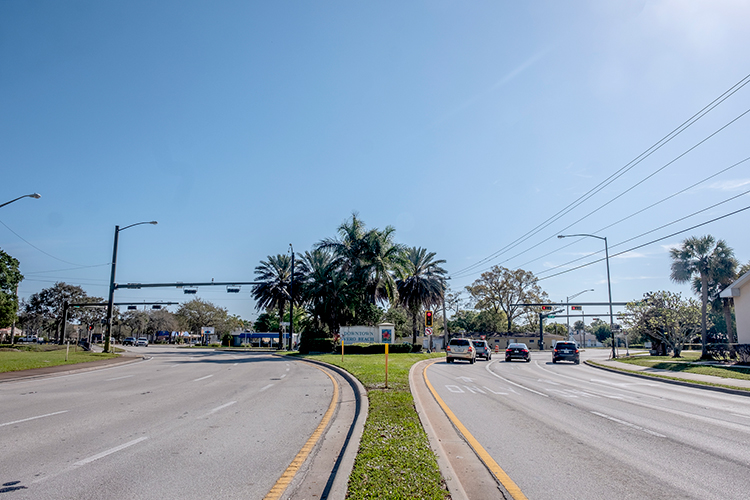
Through three public presentations in recent weeks, the community has expressed its overwhelming opposition to Vero Beach City Council’s proposed lane reduction along the Twin Pairs through downtown.
Even when proponents desperately rallied their troops for one last-gasp, all-out offensive at last week’s final presentation, the room was split, 50-50.
So why – with the latest lane-reduction proposal headed for a resounding defeat at the council’s Dec. 12 meeting – is there now talk of a compromise?
Because there should be.
Nothing major, of course: There should be no further discussion of reducing the roadway to two lanes in each direction, nor should anyone seriously consider the ridiculous and dangerous suggestion that parallel parking be added along State Road 60.
But …
Could we live with the elimination of the far-left westbound lane for a two-block stretch between 14th and 16th avenues?
Might adding a couple of bulb-outs to the curbs at those downtown intersections improve the sightlines of motorists turning onto State Road 60 and, at the same time, make it safer for pedestrians to cross the road?
What about adopting the traffic-calming measures – reducing the speed limit to 35 mph, narrowing driving lanes, adding crosswalks and adjusting the timing of traffic signals between the railroad tracks and 20th Avenue – that were approved by a previous council only two years ago?
Sounds reasonable to me.
And get this: It wouldn’t cost city taxpayers a dime, because the cost of those less-draconian improvements could be covered by the Florida Department of Transportation or, if not, using Economic Development Zone funds earmarked for the downtown area.
City Manager Monte Falls will try to convince FDOT officials that the bulb-outs are needed to address a safety issue. If he’s successful, the state might cover the costs of constructing them.
Either way, that’s certainly more palatable than asking taxpayers to cough up at least $2 million to cover the city’s share of the lane-repurposing recommendations presented by its local engineering consultant, Kimley-Horn & Associates.
The city already has spent more than $165,000 this year on another traffic study, which was conducted by Kimley-Horn earlier this year.
Besides, without broad community support for the proposed lane reduction, there’s no real chance the FDOT will include the repurposing of the Twin Pairs through downtown next year, when it launches the design phase of its planned $6.7 million State Road 60 repaving project, scheduled to begin in fiscal 2027.
Not only did all five members of the County Commission criticize the Kimley-Horn proposal during or after last month’s presentation to the Metropolitan Planning Organization, but the city election earlier this month produced a council majority that has voiced its opposition.
Surely, the two council members who’ve been pushing hard for the lane reduction – Vice Mayor Linda Moore and first termer John Carroll – would rather get some of what they wanted.
Or would they?
While Moore seems open to a compromise, Carroll has shown no sign of backing down and settling for less than everything, regardless of community’s opposition to the proposal.
But his vote might be irrelevant.
Mayor John Cotugno, meanwhile, has held his cards close to the vest, but he said publicly earlier this year that he didn’t believe a sitting council should override the decisions made by a previous council unless an egregious mistake was made.
He was among the council members who approved the recommended traffic-calming measures in 2021, so he obviously doesn’t see them as a mistake and almost certainly will vote against the more-drastic lane reduction.
But Cotugno has indicated that he would consider a compromise that offers only minor changes and includes the previously adopted measures.
So that’s two votes.
Council member Tracey Zudans has fiercely opposed the lane-reduction from the outset, saying the city should develop and adopt a downtown master plan before taking any actions on the Twin Pairs. She also voted against funding the traffic study, which again proved to be a waste of money.
But if the council comes up with a compromise that doesn’t cost the taxpayers anything?
Zudans might get on board.
If she refuses to budge, newly elected Taylor Dingle, who was scheduled to be sworn in at Wednesday’s organizational meeting, could provide the swing vote in what will be his first major issue-related decision as a council member.
Dingle said before the election that he opposed the lane-reduction proposal, but as a council newcomer who turned 28 this week, he might be eager to embrace a compromise containing only minimal and cost-free changes to the roadway.
And he should.
Let’s face it: If FDOT agrees the bulb-outs would make the State Road 60 intersections at 14th and 16th avenues safer – if the far-left westbound lane was eliminated for only two blocks and didn’t noticeably hinder traffic flow – there’s no good reason for any of the five council members to oppose such a compromise.
First, though, we need to see whether council members are willing to entertain a mostly one-sided compromise. If so, they will schedule a workshop, which likely will be conducted prior to their vote during that fateful Dec. 12 meeting.
Ultimately, the decision will be made by FDOT, which by now should have seen too much community opposition to seriously consider a lane-reduction proposal desired by only a small number of local residents, most of whom live in the city and have vested interests in the downtown area.
FDOT officials might go for something far less intrusive, however – something that satisfies concerns about Twin Pairs traffic and safety, but won’t do more harm than good.
Anyone want to compromise?



